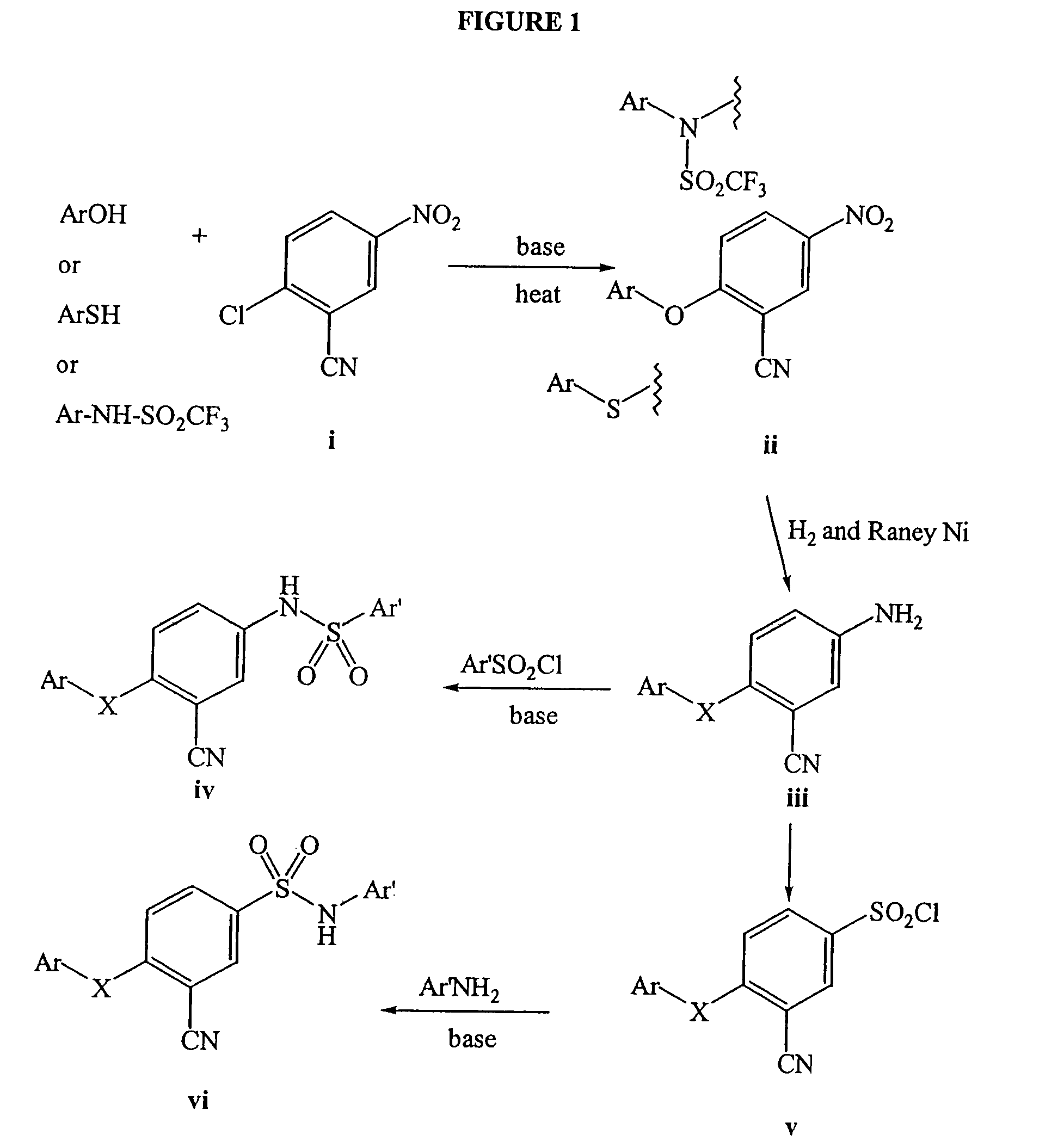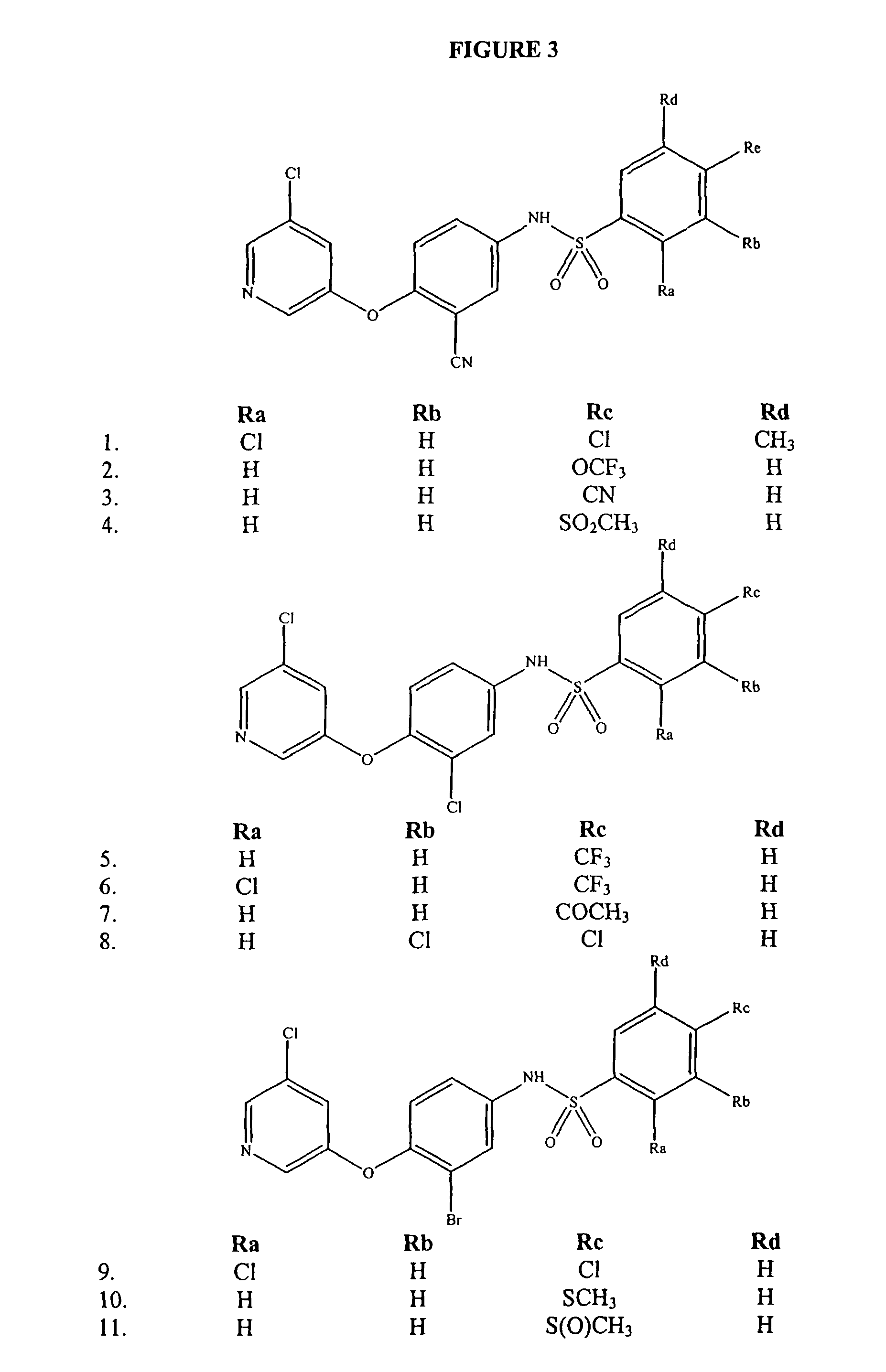Combination therapeutic compositions
a combination therapy and composition technology, applied in the field of pharmaceutical compositions, can solve the problems of increased cardiovascular risk, inability to produce insulin, complex etiology of niddm, the most prevalent form of diabetes, and possible heterogeneity
- Summary
- Abstract
- Description
- Claims
- Application Information
AI Technical Summary
Benefits of technology
Problems solved by technology
Method used
Image
Examples
example 1
[0121]This example sets forth a synthesis procedure used to generate compounds of Formula I. Compounds of Formula I were synthesized using methods as outlined in FIG. 1.
[0122]
[0123]To a mixture of 5-amino-2-(3-chloro-5-pyridyloxy)benzonitrile (0.457 g) in methylene chloride was added 2,4-dichlorobenzenesulfonyl chloride (0.456 g, from Maybridge), followed by pyridine (150 μL). The reaction progress was monitored by TLC, and upon completion the solvent was removed under vacuum. The resulting residue was partitioned between methylene chloride and water. The organic layer was drawn off and concentrated. The residue was triturated with ether to provide 0.447 g of the title compound as a white solid, mp 154-156° C.
[0124]1H NMR (400 MHz) (CDCl3) δ 8.59 (s, 1H); 8.42 (s, 1H) 8.08 (d, J=8.5 Hz, 1H); 7.72 (t, J=1.8, 1H); 7.605 (d, J=2.7 Hz, 1H) 7.53 (dd, J=8.5, 2 Hz, 1H); 7.48 (dd, J=9.4 Hz, 1H); 7.22 (s, 1H); 7.0 (d, J=9.0 Hz, 1H). m / e (M−H) 456.
[0125]The product from above was oxidized to ...
example 2
[0129]This example illustrates combination therapy of a compound of Formula I and a glitazone by oral administration.
[0130]Patients having NIDDM (Type II diabetes mellitus) are selected for therapy. The patients weigh between 70-100 kilograms. A compound of Formula I is orally administered in a dosage of 20 to 1,000 milligrams twice daily, more typically 100 mg twice daily. For infants or children the doses suggested are lowered in a linear fashion based on body weight or surface area.
[0131]Half the patient population is administered troglitazone as well as a compound of Formula I using an effective dose of both agents. The other half of the patients are administered an effective dose of troglitazone. The patients are monitored for improvement in the manifestations of the disease and for side effects, such as body weight gain and signs of liver toxicity.
[0132]The results indicate the administration of a combination of i) a compound of Formula I with ii) troglitazone increases the ef...
PUM
| Property | Measurement | Unit |
|---|---|---|
| pharmaceutical composition | aaaaa | aaaaa |
| concentration | aaaaa | aaaaa |
| resistance | aaaaa | aaaaa |
Abstract
Description
Claims
Application Information
 Login to View More
Login to View More - R&D
- Intellectual Property
- Life Sciences
- Materials
- Tech Scout
- Unparalleled Data Quality
- Higher Quality Content
- 60% Fewer Hallucinations
Browse by: Latest US Patents, China's latest patents, Technical Efficacy Thesaurus, Application Domain, Technology Topic, Popular Technical Reports.
© 2025 PatSnap. All rights reserved.Legal|Privacy policy|Modern Slavery Act Transparency Statement|Sitemap|About US| Contact US: help@patsnap.com



